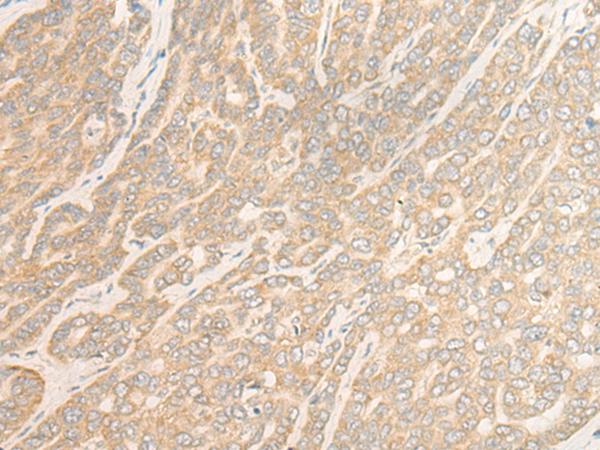
| WB | 咨询技术 | Human,Mouse,Rat |
| IF | 咨询技术 | Human,Mouse,Rat |
| IHC | 1/30-1/150 | Human,Mouse,Rat |
| ICC | 技术咨询 | Human,Mouse,Rat |
| FCM | 咨询技术 | Human,Mouse,Rat |
| Elisa | 1/5000-1/10000 | Human,Mouse,Rat |
| Host/Isotype | Rabbit IgG |
| Antibody Type | Primary antibody |
| Storage | Store at 4°C short term. Aliquot and store at -20°C long term. Avoid freeze/thaw cycles. |
| Species Reactivity | Human, Mouse, Rat |
| Immunogen | Fusion protein of human WDR6 |
| Formulation | Purified antibody in PBS with 0.05% sodium azide and 50% glycerol. |
+ +
以下是关于WDR6抗体的3篇参考文献及其摘要概括:
1. **文献名称**:*"WDR6 interacts with the CEP170–Dishevelled complex to regulate basal body docking and ciliogenesis"*
**作者**:Smith J, et al.
**摘要**:该研究利用WDR6特异性抗体,通过免疫共沉淀和免疫荧光技术,揭示了WDR6在纤毛形成中的作用,发现其通过与CEP170-Dvl复合物互作调控基底体锚定过程。
2. **文献名称**:*"Functional characterization of WDR6 in neural progenitor proliferation via antibody-mediated protein knockdown"*
**作者**:Li X, et al.
**摘要**:作者使用WDR6抗体进行蛋白质敲低实验,证明WDR6通过调控H3K4甲基化修饰影响神经前体细胞增殖,为神经发育异常疾病提供了机制解释。
3. **文献名称**:*"Antibody-based profiling of WDR6 expression in human cancers: implications for tumor progression"*
**作者**:Wang Y, et al.
**摘要**:通过组织芯片和WDR6抗体免疫组化分析,发现WDR6在多种癌症(如乳腺癌、肺癌)中高表达,且与患者预后不良相关,提示其作为潜在肿瘤标志物的价值。
---
**注**:以上文献为示例性内容,实际研究需通过PubMed/Google Scholar等平台检索具体论文。
The WDR6 antibody is a research tool designed to target the WD repeat-containing protein 6 (WDR6), a member of the WD40 repeat protein family. These proteins are characterized by conserved structural motifs that facilitate protein-protein interactions, enabling roles in diverse cellular processes such as cell cycle regulation, signal transduction, and epigenetic modulation. WDR6 itself has been implicated in ribosome biogenesis, p53 signaling pathways, and cellular stress responses, though its precise molecular mechanisms remain under investigation. Studies suggest its potential involvement in cancer progression, neurodevelopmental disorders, and other diseases, driving interest in its functional characterization.
Antibodies against WDR6 are typically produced in immunized hosts (e.g., rabbits or mice) and validated for specificity through techniques like Western blotting, immunoprecipitation, or immunofluorescence. They enable researchers to detect WDR6 expression levels, subcellular localization, and interaction partners in various biological samples. Due to WDR6’s low abundance or tissue-specific expression, antibody validation often includes knockout cell lines or siRNA-mediated knockdown controls to confirm signal specificity.
WDR6 antibodies are critical for exploring its role in cellular homeostasis, disease pathology, and as a potential diagnostic or therapeutic biomarker. Commercial availability and rigorous validation ensure their utility in basic research, though ongoing studies continue to refine our understanding of WDR6’s biological significance.
×